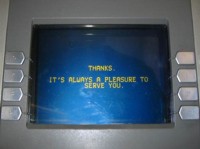| Business and Commerce | ||||
|
Businesses have always had to keep records. Originally this would have been done on paper, but nowadays the data would be stored in databases. Complex software is now used to manage databases called DBMS (Database Management Systems). These allow a number of users to access the same database, add and edit records, and use the data for searches etc. The DBMS can also manage the security of the data and perform validation checks. Example A college has a database of all the courses it offers and details of the students who are taking each course. There is a LAN so this data can be accessed from a number of workstations around the campus. The progress of the students in each course can be recorded by tutors in all the different faculties. Some examples of commercial computer systems : Banking Systems Computers are used to keep track of all the bank transactions. Customer accounts need to be updated every time a payment transaction is made whether by cheque, card, or EFT. Standing orders and Direct Debits are dealt with automatically by the BACS (Bankers Automated Clearing Service) computer and money is transferred between accounts.
|
||||
|
EFT (Electronic Funds
Transfer) is the moving of money from one bank
account to another without any paper transactions. People can be
paid their wages and spend them without handling any actual
money.
|
||||
|
||||
| EFTPOS - customers in a shop can submit their bank card to be inserted into a reader attached to the POS terminal. The payment is then made directly from the customer's bank account to that of the shop. | ||||


